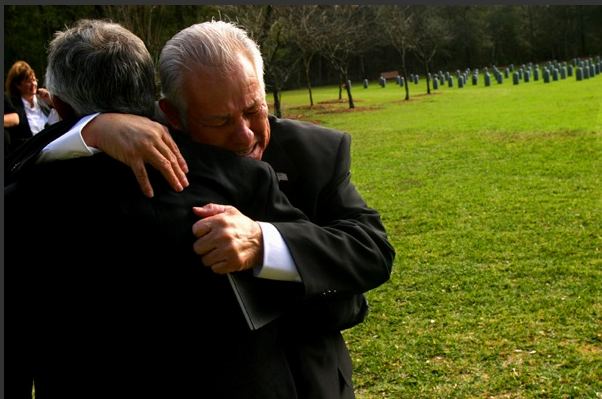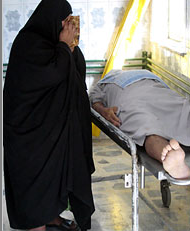In November, 2000, President Clinton traveled to Hanoi and stated in a speech there that “This shared suffering has given our countries a relationship unlike any other.” The statement need not be literally true to be an achievement. To the extent that it became true that day, it was something that reflected not only the war but also the healing and growing together that had ensued in the followed decades. Let us hope that some day the same can be said for the US and Iraq. It surely would take time, but the reason for doing so is already all evident in photojournalism’s coverage of this war.
Two examples brought this thought to mind. One was the post at BAGnewsNotes yesterday about a new book by photographer Andrew Lichtenstein entitled Never Coming Home. Lichtenstein chronicles eight of the funerals occurring across America for those killed in the war. You can see some of these heartrending images in a photo essay at Alternet. One of a father collapsing in grief on someone’s shoulder is undoubtedly a portrait of suffering:

And for every loved one lost here, there are many more destroyed over there. This image from yesterday’s New York Times is one example of how grief knows no boundaries:
The caption of this page 10 story says that “An Iraqi woman wept next to her husband’s body yesterday in Baquba. Violent civilian deaths in Iraq declined last month.” That mixed message is typical of Times coverage of late (some would say, all the time). We can be certain, however, that the statistical decline means little to this woman. What remains to be seen is whether we can make an emotional connection across the barriers of war, geography, and culture.
Unfortunately, while the visual image may be the best means to establish empathy on the scale required, the archive presents its own obstacles to emotional understanding. While the photographs of American grief are now available in an elegiac photo essay and a beautiful book, those of Iraqi parents are not getting quite the same packaging. This photo appeared as a black and white image in the print edition, and then as a thumbnail image online. I was grateful that it was there, but the thumbnail sizing seems almost obscene, as if a deliberate strategy to minimize the depth of her loss. And while the American dead are respectfully interred in closed caskets, her husband’s body is laid out as if on a slab at the city morgue or as a cadaver suitable for an anatomy class. And instead of seeing the father’s face contorted in grief, hers is obscured by a handkerchief. Instead of seeing an individual, we see an anonymous figure draped in the burqa that signals, to the Western gaze, the less than full personhood of those confined within traditional cultures. The only means of communication are her hands. A message may be there, but we see only the gesture of loss, experienced by a social type, the Iraqi woman. That is a long way from sharing suffering.
And yet she does touch me. There is so little left in that room, and the light coming in like a breeze flowing through the window hints at a transfiguration, as if his spirit has already ascended. That may be, but she stands there like a pillar of grief. If only she had a shoulder to cry on. One of ours, perhaps.
Photographs by Andrew Lichtenstein; Ali Mohammed/European Pressphoto Agency.

Discussion